This just in from the Great Stems Police Department — be on the lookout in your own garden!
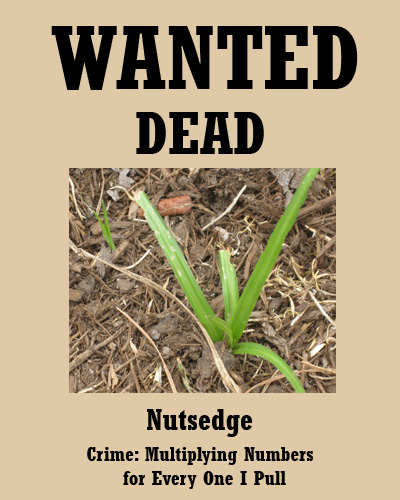
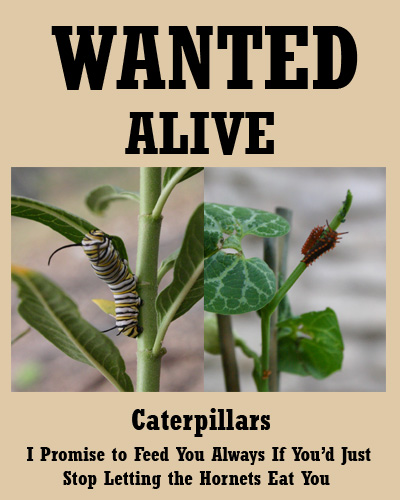
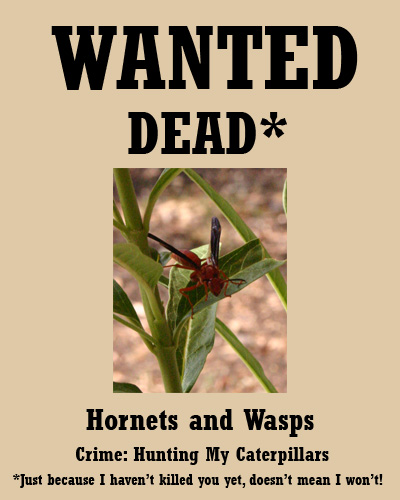
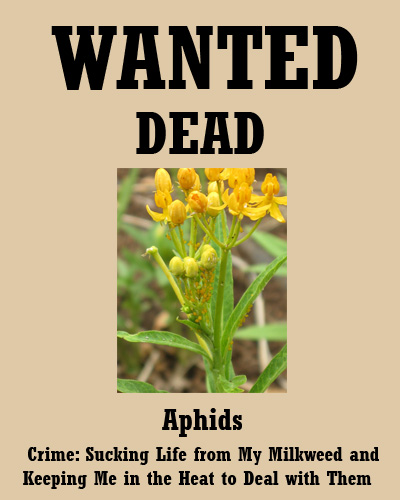
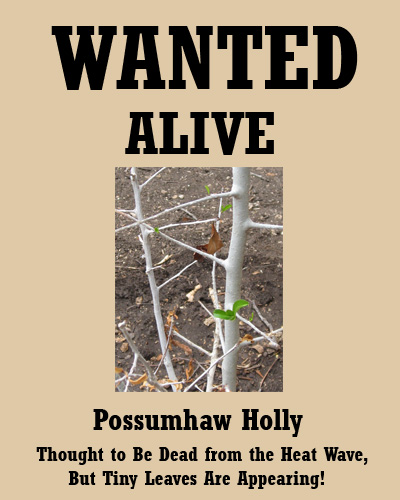
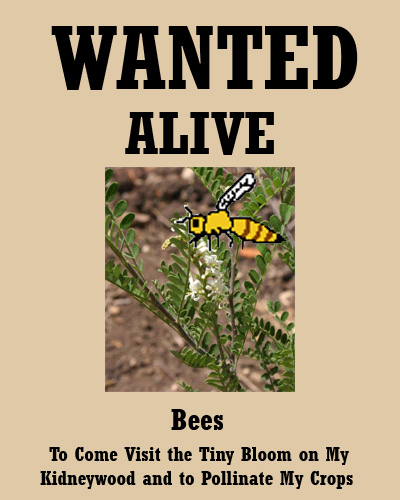
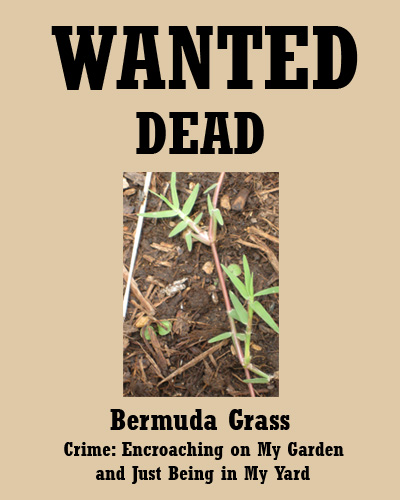
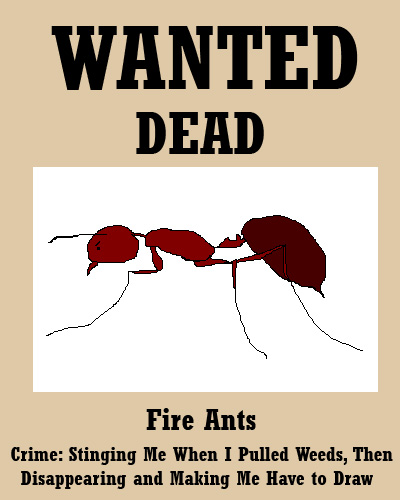
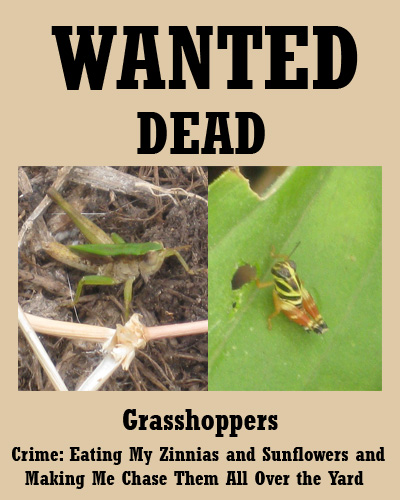
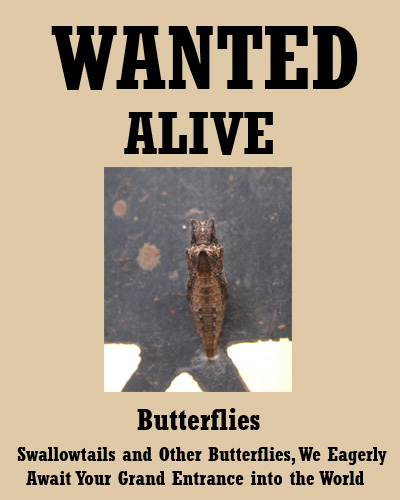
Should you happen upon any of these Wanted creatures, please take appropriate action and as necessary, contact your local authorities.
This just in from the Great Stems Police Department — be on the lookout in your own garden!










Should you happen upon any of these Wanted creatures, please take appropriate action and as necessary, contact your local authorities.
Gardening is still such a mystery to me. What should work doesn’t, and what shouldn’t work does. I know there are all sorts of Murphy’s Laws when it comes to this crazy hobby. Here’s what I’ve discovered about the way gardening works. Gardening gods, why do you forsake me?!!
*Why is it that you promise yourself most determinedly that this time you will not buy any plants, and when you get to the nursery you realize that not just one, but two of your most coveted hard-to-find plants have just arrived off the truck? (here is more Dutchman’s Pipevine — the other, non-pictured is a native milkweed I rarely see)
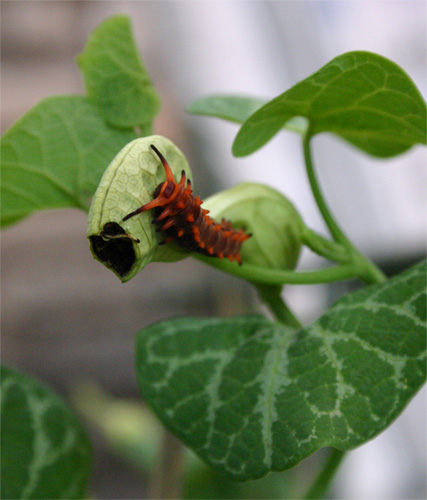 *Why is it that you wait so long for the first monarch of the season, and when you finally see one you discover all your milkweed is covered in aphids?
*Why is it that you wait so long for the first monarch of the season, and when you finally see one you discover all your milkweed is covered in aphids?
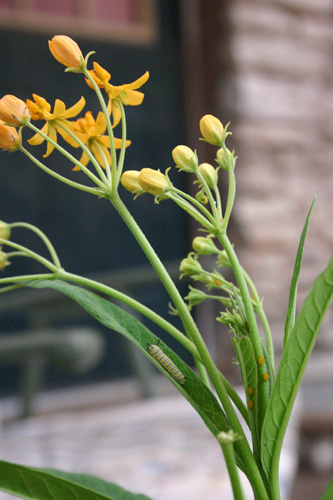
 *On the same note, why is it that ladybugs show up when there aren’t any aphids and leave before the ferocious onslaught of the little sap-suckers?
*On the same note, why is it that ladybugs show up when there aren’t any aphids and leave before the ferocious onslaught of the little sap-suckers?
*Why is it that your darling dogs have an impelling need to lay on and compact any dirt you till, and another impelling need to dig up any freshly planted garden bed? (This photo, by the way, is of the naughty dog that keeps getting in the pond. She’s usually camera-shy. Don’t be fooled by her gorgeous fur. It hides an imp.)
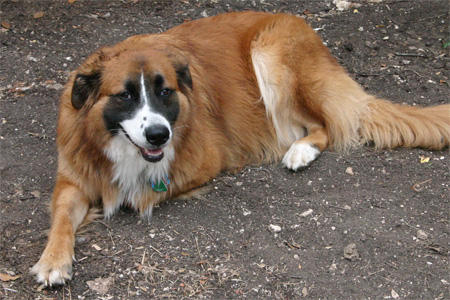 *And why is it that your yard can have plenty of available (dog) fertilizer but you can’t use one bit of it to make compost?
*And why is it that your yard can have plenty of available (dog) fertilizer but you can’t use one bit of it to make compost?
*Why is it that the bag that spills in the car is not the bag of pine straw, and not even the pleasant smelling potting soil, but the compost made from cow manure?
*Why is that you set out birdfeeders for hummingbirds and cardinals and what you get instead are gluttonous, wasteful doves and predatory wasps? (Ok, really, I get them all.)
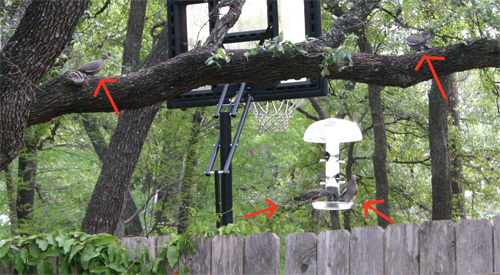
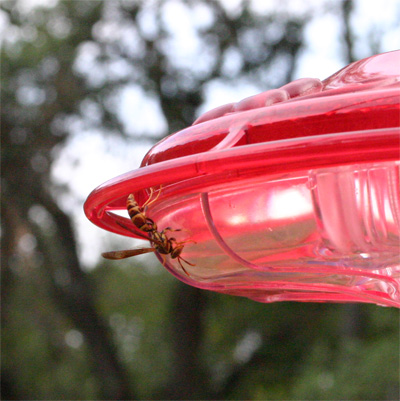
*Why is it that the pond you enjoy so much attracts, among other creatures, hornets and wasps that take a nice long, happy drink before going and killing your beloved caterpillars? (Sad note: the monarch caterpillar in the milkweed picture above, along with all its buddies, disappeared during the writing of this blog entry. Stupid, but necessary predators.)
*Why is that you attempt to sacrifice yourself to the gods for some rain by putting up a metal trellis while standing on a partially metal ladder with wire cutters and a hammer in your hand and thunder and lightning in the distance, and all you get is a few sprinkles, like a spit in the eye?
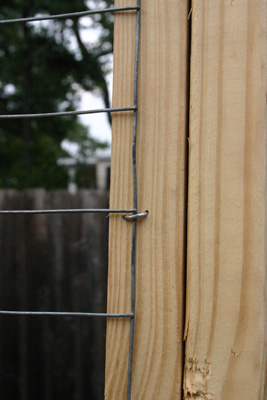 *Why is it that you don’t realize you have to stop at the grocery store on the way home until after you’ve covered yourself in stinky compost while bagging it at the nursery?
*Why is it that you don’t realize you have to stop at the grocery store on the way home until after you’ve covered yourself in stinky compost while bagging it at the nursery?
*Why is it that you buy a beautiful tree that you are determined to keep alive because it needs to shade the A/C unit and because it is replacing one that died, and it dies while the one that the dogs dug up multiple times over the winter is the one that is thriving? (Actually, three trees the dogs mostly destroyed came back and are doing well.)
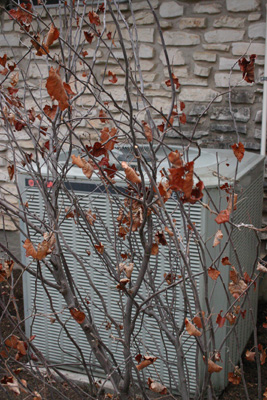
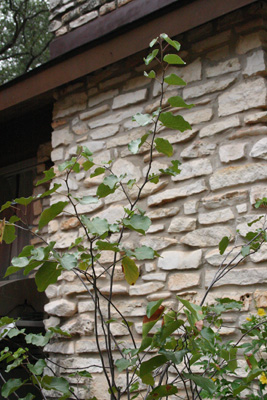 *Why is it that the young trees you rarely water (including two you forgot about for weeks in your garage after the last frost) survive, but the ones you faithfully water on a recommended schedule die?
*Why is it that the young trees you rarely water (including two you forgot about for weeks in your garage after the last frost) survive, but the ones you faithfully water on a recommended schedule die?
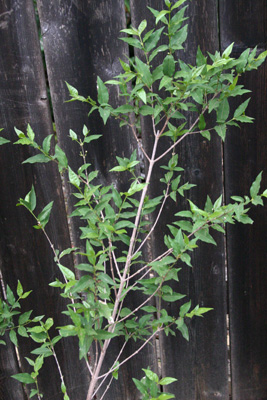 *Why is it that the plants you still haven’t managed to put mulch around are doing better than the ones you surrounded with three inches of mulch?
*Why is it that the plants you still haven’t managed to put mulch around are doing better than the ones you surrounded with three inches of mulch?
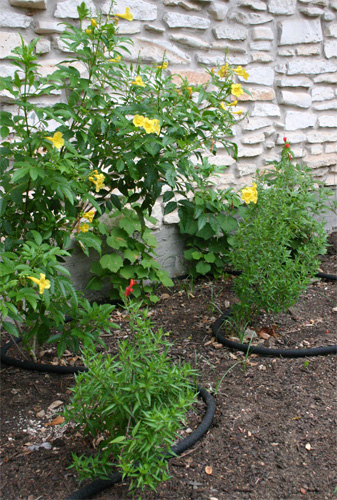
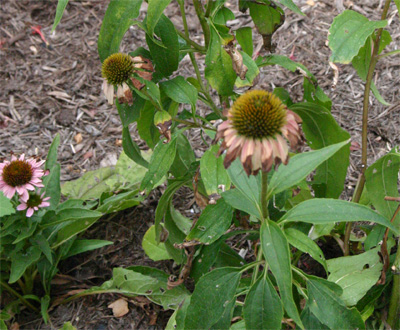
*Why is it that the most amazing, beautiful sights in your garden happen when your camera is nowhere near?
*Why is it that a random new seedling grows in your yard and you have to wait until it gets big to find out what it is, or whether it is friend (keeper) or foe (weed or invasive)? This one looks like a friend, I hope, but I don’t know what it is yet.
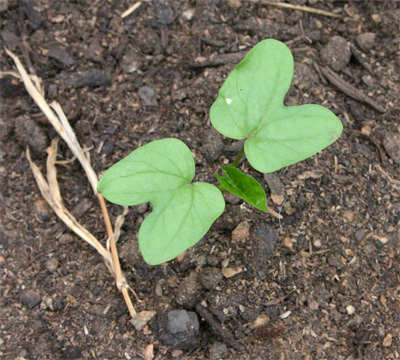 *Why is it that your son doesn’t want to work outside when it’s hot, but then when it’s cool and overcast, he still doesn’t want to work? Oh wait, I know that one.
*Why is it that your son doesn’t want to work outside when it’s hot, but then when it’s cool and overcast, he still doesn’t want to work? Oh wait, I know that one.
*(from the son) Why is it that your mom always makes you work, but barely ever lets you goof around? Oh wait, I know that one. (from the Mom: clearly I just let him goof around)
*Why is it that your beautiful plants take so long to grow, but your weeds grow like… well, weeds?
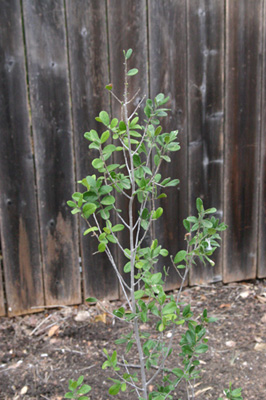 *(from the other son) Why is it that every time you want to plant something, your mom doesn’t have a plant to plant? But when you don’t want to plant something, she has lots and lots.
*(from the other son) Why is it that every time you want to plant something, your mom doesn’t have a plant to plant? But when you don’t want to plant something, she has lots and lots.
*Why is it that you lovingly make several cost-effective environmentally-friendly thistle socks for the birdies, and the finches tear such big holes in them until the socks won’t hold any more seed, making you want to reconsider plastic? (technically these two are the brand-name socks — I’d already removed the destroyed homemade ones… I guess I better get busy making more)
 *Why is it that you work so hard to create a great garden for your new veggies and then realize that you managed to let some of your herbs die in the process?
*Why is it that you work so hard to create a great garden for your new veggies and then realize that you managed to let some of your herbs die in the process?
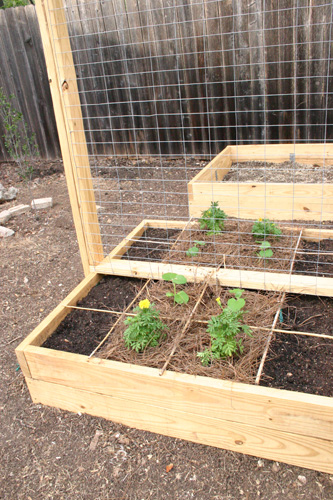
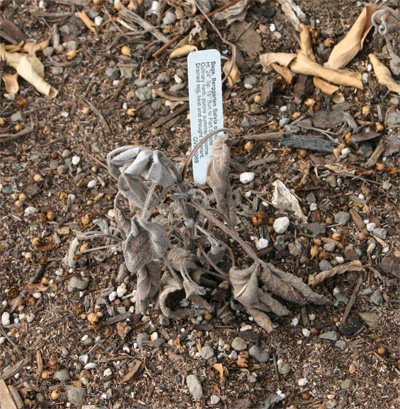 *Why is it that you can spend so much time making your outside yard beautiful and neglect your poor house plants?
*Why is it that you can spend so much time making your outside yard beautiful and neglect your poor house plants?
*(from the husband) Why is it that dinner isn’t ready yet? Oh wait, I know that one.
Got any to add? Please share them! I have a feeling this is a non-ending list!
Author’s edit on 7/26/09: How could I forget this major one: Why is it that I finally start gardening, and Texas finds itself in the middle of perhaps its worst drought ever, with drastically reduced water availability and temperatures over 100 degrees all summer long?
Day 6… Separating the Seedlings
Now that I’ve gotten over the shock of discovering that once again I stuck myself into an enormous project I’m not ready for, I’m moving ahead full force. Because that’s how I roll, baby! My pumpkin army will help me conquer the world! Muahahaha!
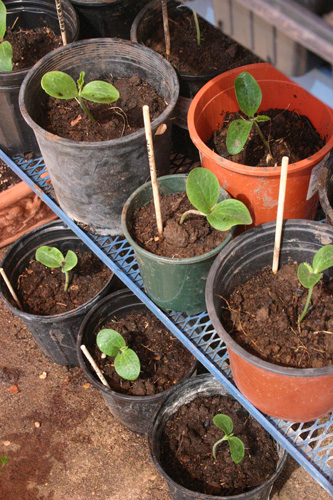 The pumpkins, cantaloupes, and endurance sunflowers are all growing like mad. Today I separated almost all of the seedlings into individual pots, which was quite a chore given that I only have so many available pots — I used the last of my cups, too. I heartlessly thinned out a few that looked at me funny (ok that’s a lie, because it really is painful for me to decide which ones have to go). In all I think I sent 4 little pumpkin plants to their doom, but they will serve another purpose in becoming compost. It means I still have about 20 pumpkin seedlings growing, LOL (I was afraid to count the cantaloupes). I recognize that I can’t possibly grow them all, but I’ll choose the best of the best after my camping trip this week. If any survive my husband’s attempt to water the seedlings in my absence, they are sure to be hardy little boogers.
The pumpkins, cantaloupes, and endurance sunflowers are all growing like mad. Today I separated almost all of the seedlings into individual pots, which was quite a chore given that I only have so many available pots — I used the last of my cups, too. I heartlessly thinned out a few that looked at me funny (ok that’s a lie, because it really is painful for me to decide which ones have to go). In all I think I sent 4 little pumpkin plants to their doom, but they will serve another purpose in becoming compost. It means I still have about 20 pumpkin seedlings growing, LOL (I was afraid to count the cantaloupes). I recognize that I can’t possibly grow them all, but I’ll choose the best of the best after my camping trip this week. If any survive my husband’s attempt to water the seedlings in my absence, they are sure to be hardy little boogers.
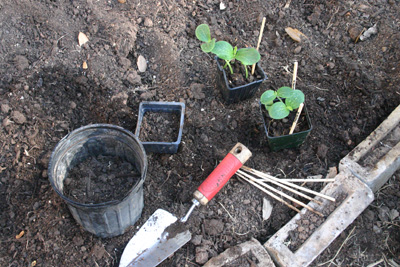
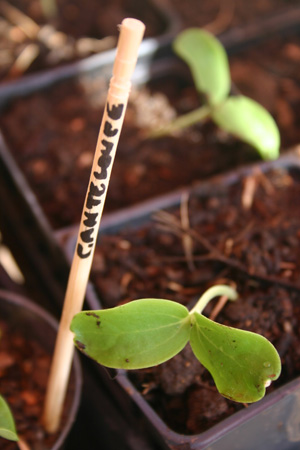 The current plan is to put some plants in the ground and some in raised beds with trellises. It will be quite the experiment for this newbie vegetable gardener. I happened upon the wonderful blog of Engineered Garden, and it’s this type of trellis we plan to build, at least for the cantaloupes. Actually, I’ve asked my DH to build them for me while the boys and I are camping. If he succeeds, I should be able to get most of my babies planted next weekend. These seedlings are growing so fast, I hope I don’t miss the best window for planting.
The current plan is to put some plants in the ground and some in raised beds with trellises. It will be quite the experiment for this newbie vegetable gardener. I happened upon the wonderful blog of Engineered Garden, and it’s this type of trellis we plan to build, at least for the cantaloupes. Actually, I’ve asked my DH to build them for me while the boys and I are camping. If he succeeds, I should be able to get most of my babies planted next weekend. These seedlings are growing so fast, I hope I don’t miss the best window for planting.
Knowing that I’m camping for a week and leaving my plants (seedlings plus the rest of the garden) during a Texas heat wave in the care of my husband, who is NOT the gardener of the family, is a bit scary for me. I think it will take me two hours to write out the whole watering process I go through. But it will be good for him. If I teach him anything, it will be how to deep water, an important skill to have. I worry most that he’ll not notice all the plants around the place. He will also have to fill all the birdfeeders and take care of the pond, dogs, cats, hamster, fish, and our neighbor’s turtles — all while working a full-time job. See why I worry?
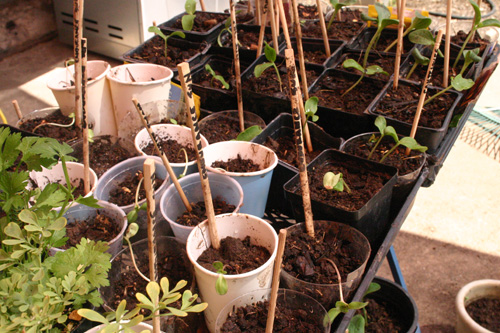 I’m sad that our swallowtail caterpillars will go to chrysalis while we are gone — we won’t get to see how big they’ll get before they transition. But if they form their chrysalises nearby, and we can find them, maybe we’ll get to see them emerge as beautiful butterflies.
I’m sad that our swallowtail caterpillars will go to chrysalis while we are gone — we won’t get to see how big they’ll get before they transition. But if they form their chrysalises nearby, and we can find them, maybe we’ll get to see them emerge as beautiful butterflies.
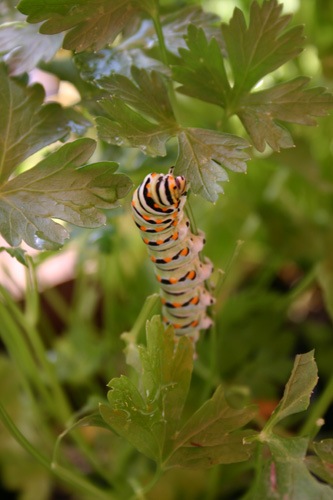
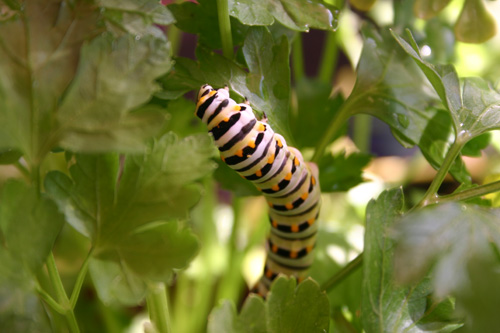 And I’m going to miss Garden Bloggers’ Bloom Day. But most of my plants have given up their blooms in hopes of sheer survival in the heat (thankfully we have a few left for the butterflies). But here’s a new one I’ll post — one of my other Flame Acanthus has finally started blooming, and I was happy to see it was the vibrant red variety. My other Flame Acanthus has orange blooms.
And I’m going to miss Garden Bloggers’ Bloom Day. But most of my plants have given up their blooms in hopes of sheer survival in the heat (thankfully we have a few left for the butterflies). But here’s a new one I’ll post — one of my other Flame Acanthus has finally started blooming, and I was happy to see it was the vibrant red variety. My other Flame Acanthus has orange blooms.
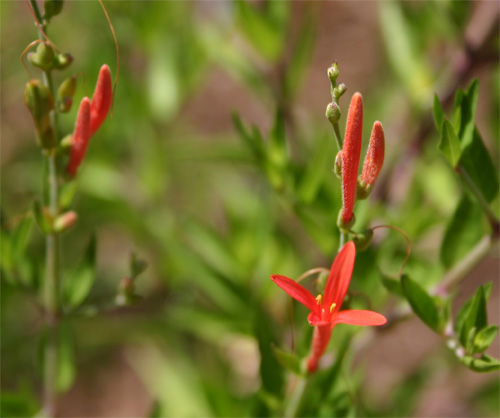 See you next week!
See you next week!
There are several alternative titles to this post, namely:
Obviously, even the list is growing.
You see, I’ve done it again. I got a creative, eager bug (no pun intended), an idea quite simple in concept, and then I once again found myself in the middle of a major ordeal.
The pond is an example. I found free rocks and came up with the idea of a pond. Months of back-breaking work later, we finally finished the project. Simple idea. Ordeal to deliver.
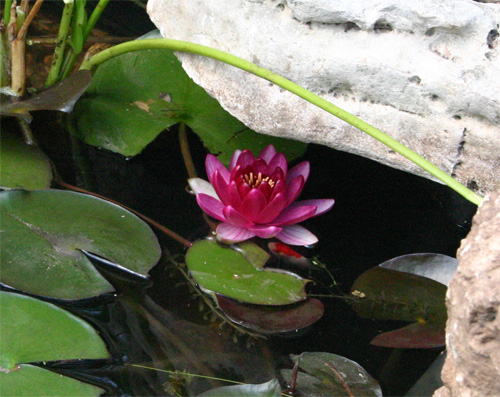 Here’s another one – my first and only mosaic (Edit: Okay, this is no longer true). That’s the Pennybacker bridge here in Austin – also known as the 360 bridge. Took me about two months to make. I really need to learn to stop undertaking big projects I know practically to completely nothing about doing. Oh, but then I’d have to stop gardening. Moving on!
Here’s another one – my first and only mosaic (Edit: Okay, this is no longer true). That’s the Pennybacker bridge here in Austin – also known as the 360 bridge. Took me about two months to make. I really need to learn to stop undertaking big projects I know practically to completely nothing about doing. Oh, but then I’d have to stop gardening. Moving on!
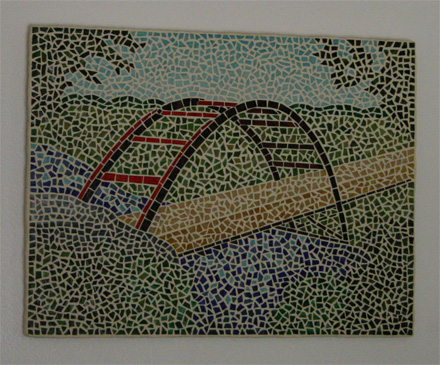 Even my “simple” act of finding a wonderful man to marry and raise a family with… Did he tell me ahead of time that he came from a family of 10+-pound children? Guess where I learned that whopper? In the hospital, after having giving birth to our first child, a 10 lb-4.5 oz whopper of a boy with the biggest feet the nurses had ever seen. (Currently he’s in a size 13 shoe and not even a teenager yet).
Even my “simple” act of finding a wonderful man to marry and raise a family with… Did he tell me ahead of time that he came from a family of 10+-pound children? Guess where I learned that whopper? In the hospital, after having giving birth to our first child, a 10 lb-4.5 oz whopper of a boy with the biggest feet the nurses had ever seen. (Currently he’s in a size 13 shoe and not even a teenager yet).
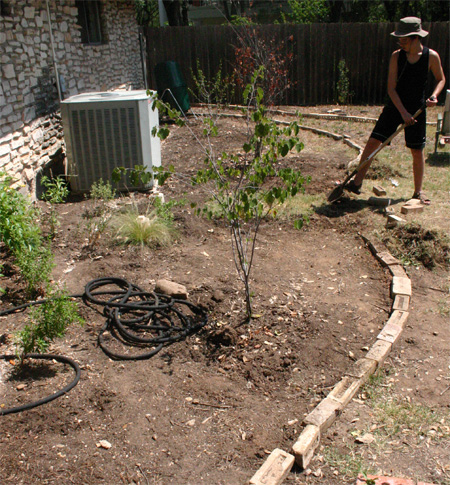 Ah well, at least my son has become an excellent soil digger, when he’s not complaining about the work and the heat and… I digress. But that kid fits nicely into today’s blog saga about crazy gigantic growing things. (The bed in the picture is in progress, btw – eventually the bricks, outlining the shape, will go away and we’ll have plants + decomposed granite path.)
Ah well, at least my son has become an excellent soil digger, when he’s not complaining about the work and the heat and… I digress. But that kid fits nicely into today’s blog saga about crazy gigantic growing things. (The bed in the picture is in progress, btw – eventually the bricks, outlining the shape, will go away and we’ll have plants + decomposed granite path.)
Last week my youngest son (since you might be wondering, he was more than 9 pounds at birth) and I decided that we wanted to grow our own jack-o-lanterns this year. The same day, he helped me scoop out the seeds of a cantaloupe, and we decided we’d try to grow them, too. After all, I had some empty beds I was waiting to plant until fall, anyway, and some I needed an excuse to work on. Besides, I wasn’t worried – my last purple coneflower seeds and two rounds of sunflower attempts didn’t work, so my chance of getting any seedlings from such fresh cantaloupe seeds and potentially old pumpkin seeds was surely low.
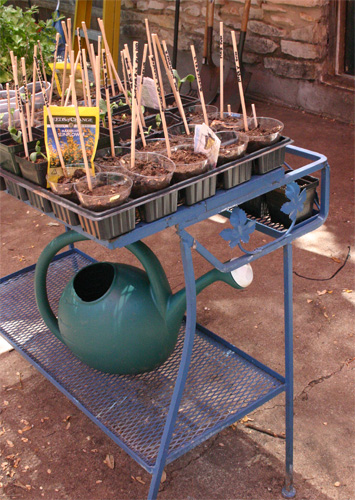 Oh, and while I was at it, I thought, I’ll try two other types of sunflower seeds. Oh, and look, here are butterfly flower seeds! Oh, and white swan coneflower seeds! Oh, and look at the cute little swallowtail caterpillars on this fennel. I’ll buy some fennel, and some parsley so the caterpillars can have a yummy salad. And I get to try out my little garden bar I just bought off of craigslist for a new potter’s bench! Woot, what a good gardener I am!
Oh, and while I was at it, I thought, I’ll try two other types of sunflower seeds. Oh, and look, here are butterfly flower seeds! Oh, and white swan coneflower seeds! Oh, and look at the cute little swallowtail caterpillars on this fennel. I’ll buy some fennel, and some parsley so the caterpillars can have a yummy salad. And I get to try out my little garden bar I just bought off of craigslist for a new potter’s bench! Woot, what a good gardener I am!
<face palm>
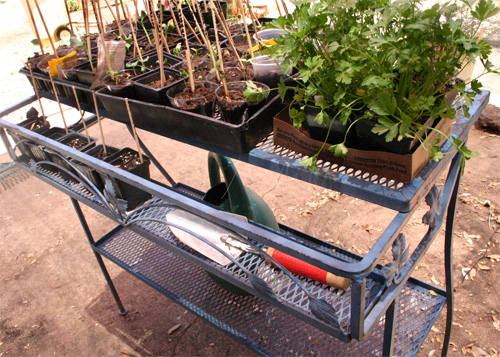 I planted the seeds on Sunday. I ran out of little planters and resorted to cups I’d had in the cabinet for years. And I finally found a use for the hundreds of chopsticks we’d accumulated over the years from the occasional take-out – labels! But to my horror — within two days -TWO DAYS – of planting my seeds, I already had sprouts.
I planted the seeds on Sunday. I ran out of little planters and resorted to cups I’d had in the cabinet for years. And I finally found a use for the hundreds of chopsticks we’d accumulated over the years from the occasional take-out – labels! But to my horror — within two days -TWO DAYS – of planting my seeds, I already had sprouts.
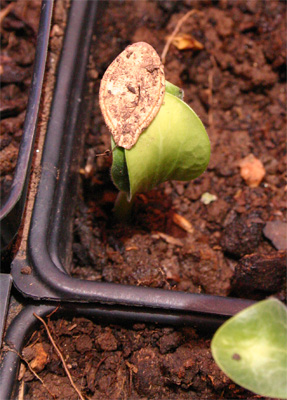 And not just little tiny barely-poking-out-of-the-ground seedlings – these seem to be sprouts ready to take over the planet. I swear they are growing before my eyes!
And not just little tiny barely-poking-out-of-the-ground seedlings – these seem to be sprouts ready to take over the planet. I swear they are growing before my eyes!
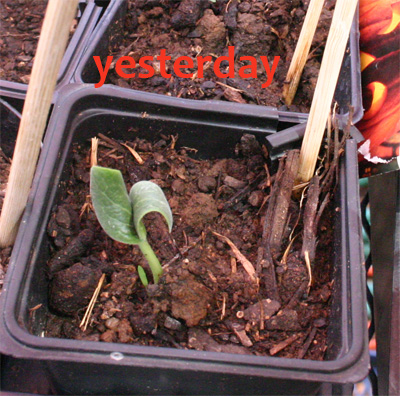
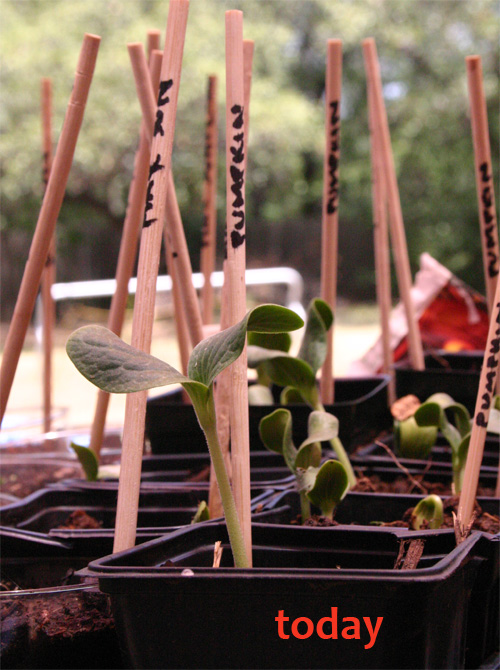 So I rushed to Google exactly what I’ve gotten myself into with the pumpkin and cantaloupe and other plants. Oh my – 15- to 40-foot pumpin vines? One plant needs 100 square feet of space? Noooooooo. The package said nothing about that. Honey, we a bigger garden bed – about the size of the whole backyard! And we have a big yard, mind you. Suddenly our simple idea has led to yet another huge project.
So I rushed to Google exactly what I’ve gotten myself into with the pumpkin and cantaloupe and other plants. Oh my – 15- to 40-foot pumpin vines? One plant needs 100 square feet of space? Noooooooo. The package said nothing about that. Honey, we a bigger garden bed – about the size of the whole backyard! And we have a big yard, mind you. Suddenly our simple idea has led to yet another huge project.
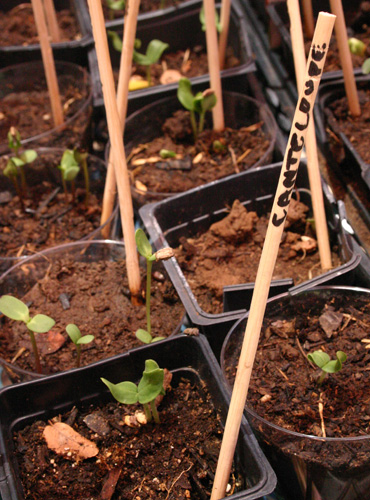 The sunflowers shocked me by growing as well. The Endurance sunflowers, listed as “Rare” – popped out on Day 2 with the pumpkins. The Maximillian sunflowers are also sprouting. I thought my butterfly flowers already were, but I was confused – it was another sunflower. According to the package (and the white swans), they have another two weeks or so before I need to worry about them. At least they’ll give me time to get the monster vines in the ground. (Did I just hear a butterfly flower seed open in response?)
The sunflowers shocked me by growing as well. The Endurance sunflowers, listed as “Rare” – popped out on Day 2 with the pumpkins. The Maximillian sunflowers are also sprouting. I thought my butterfly flowers already were, but I was confused – it was another sunflower. According to the package (and the white swans), they have another two weeks or so before I need to worry about them. At least they’ll give me time to get the monster vines in the ground. (Did I just hear a butterfly flower seed open in response?)
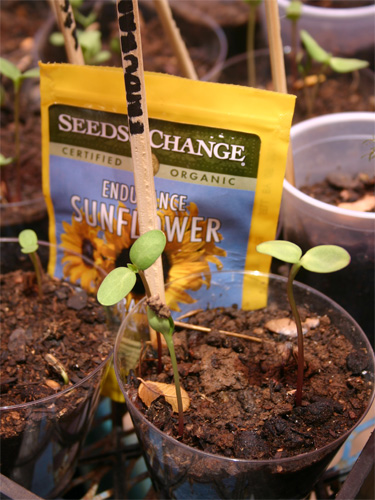
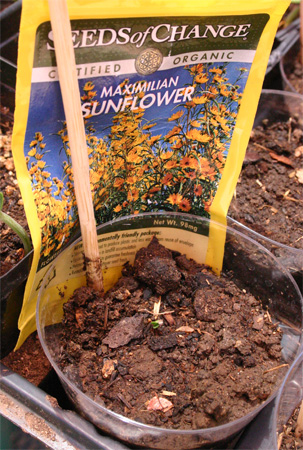 And my cute little caterpillars? Doubled in size overnight. They are running out of fennel, and they seem to have no interest in the parsley. I see more tiny little baby swallowtail caterpillars have also hatched (and are growing!). I’m going to have to hunt down some more fennel or try carrot tops or something. Argh.
And my cute little caterpillars? Doubled in size overnight. They are running out of fennel, and they seem to have no interest in the parsley. I see more tiny little baby swallowtail caterpillars have also hatched (and are growing!). I’m going to have to hunt down some more fennel or try carrot tops or something. Argh.
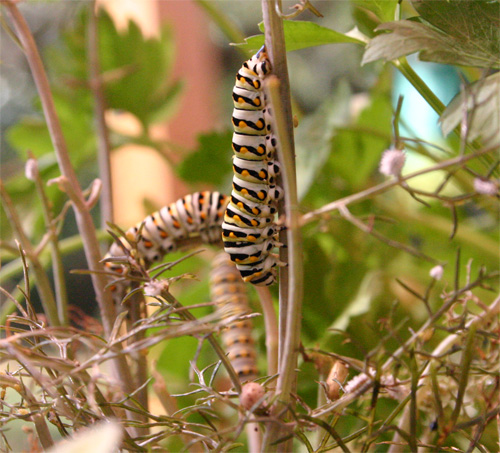 Don’t be fooled by the parsley — that cat is on fennel!
Don’t be fooled by the parsley — that cat is on fennel!
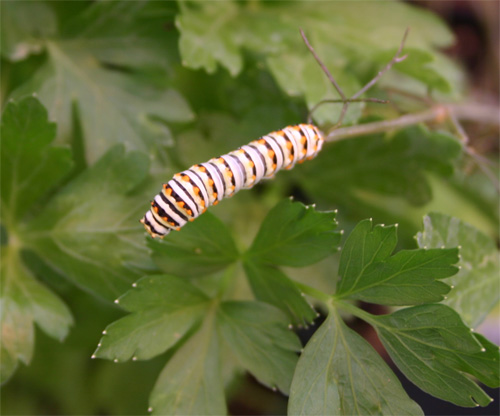 And what is this little white mop-like creature?
And what is this little white mop-like creature? I hope it’s a good guy, not a little pesty thing. If you can ID it for me, I’d be grateful! Note: It’s a good guy, though not native to the states: Mealybug Destroyer (Cryptolaemus montrouzieri). Eater of aphids and mealybugs and other little pests!
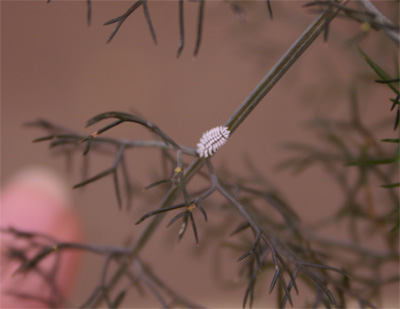
Well, that’s how it grows, I guess (bad pun intended, lol).
I really think I need a new blog category to accommodate this and all future entries about my horrible inability to think ahead. Today’s post will be the first in “What was I thinking?” category. I should also add that I’m horrible at chess. And apparently when I endearingly called my son Pumpkin in his younger years, I was way more on target than I thought.
Here’s a lovely tree I bet everyone will want to have. Just look at the size of these beautiful red blooms!
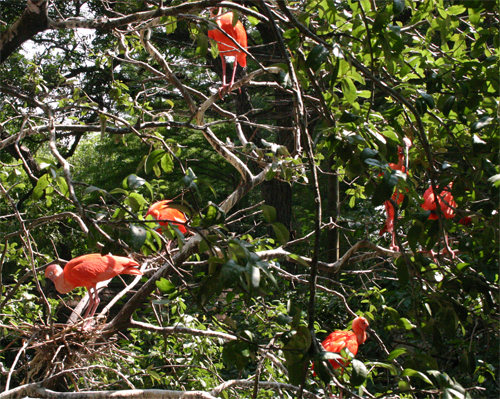 Allright, allright, they are scarlet ibis nesting in a tree in the San Antonio Zoo. Yesterday I herded my own little pack of wild animals among exotic plants and creatures from all over the world. I had great intentions to go from the zoo over to the San Antonio Botanical Gardens, but somehow the day slipped by and we were still at the zoo. By the time I realized that I wasn’t going to make it over to the gardens, I’d wished I’d taken more pictures of the beautiful plants that graced the zoo. Still, I did manage to get a few.
Allright, allright, they are scarlet ibis nesting in a tree in the San Antonio Zoo. Yesterday I herded my own little pack of wild animals among exotic plants and creatures from all over the world. I had great intentions to go from the zoo over to the San Antonio Botanical Gardens, but somehow the day slipped by and we were still at the zoo. By the time I realized that I wasn’t going to make it over to the gardens, I’d wished I’d taken more pictures of the beautiful plants that graced the zoo. Still, I did manage to get a few.
Like this banana plant. I hope they treat the apes and monkeys to these yummy treats when they are ripe enough!
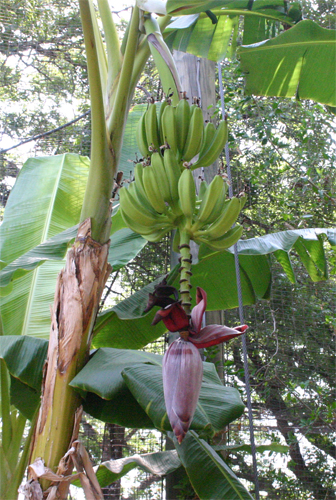 This bamboo was gigantic enough to unfortunately invite some graffiti from zoo visitors. While I hate to see such careless destruction on the part of passersby, I found the bamboo an interesting setting for urban art and lettering.
This bamboo was gigantic enough to unfortunately invite some graffiti from zoo visitors. While I hate to see such careless destruction on the part of passersby, I found the bamboo an interesting setting for urban art and lettering.
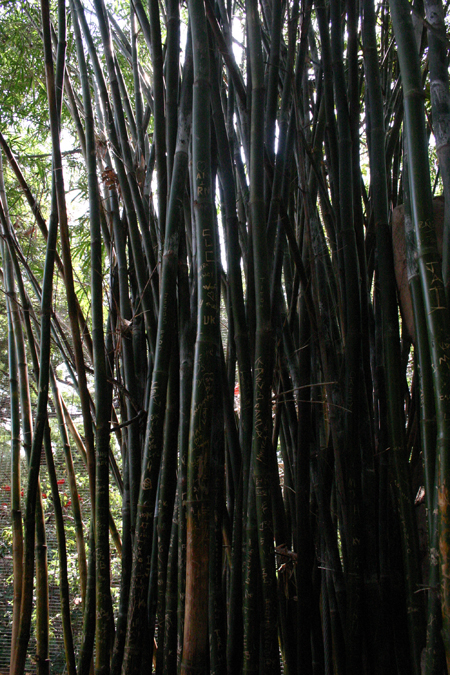 I did find that the zoo was pretty good about labeling the various Texas native plants around the park, but the exotics weren’t so well labeled, at least not the ones I was particularly interested in, of course. Oh, I really liked this plant, whatever its name might be.
I did find that the zoo was pretty good about labeling the various Texas native plants around the park, but the exotics weren’t so well labeled, at least not the ones I was particularly interested in, of course. Oh, I really liked this plant, whatever its name might be.
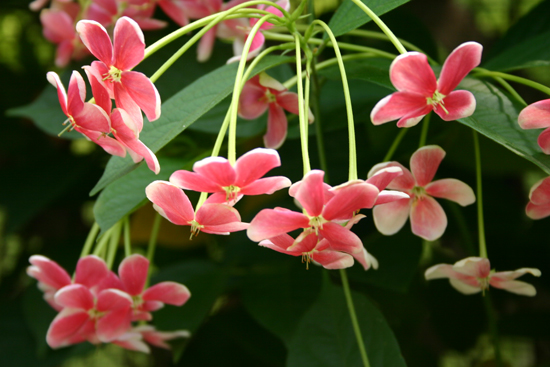
This is a very vibrant shrimp plant — I’m not sure of the variety. My young (and red) shrimp plants still aren’t blooming. I hope that they’ll be busy bloomers in their second year, if not this year.
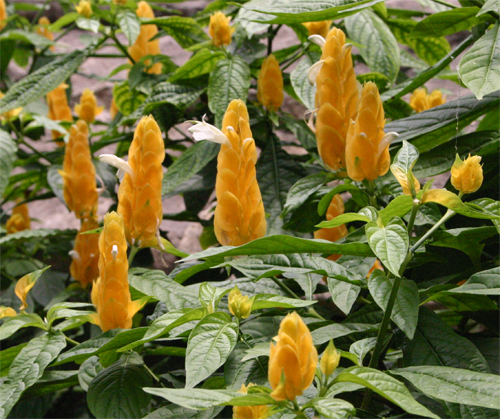
The lion’s tail, also called lion’s mane, is very striking. This was the first time I’d seen one in person.
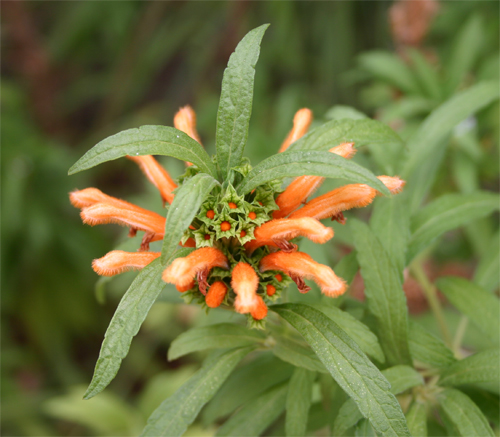 The zoo has opened a butterfly center, which was delightful. Many different species of butterflies fluttered all around us, enjoying nectar and orange slices. The monarchs were quite willing to pose.
The zoo has opened a butterfly center, which was delightful. Many different species of butterflies fluttered all around us, enjoying nectar and orange slices. The monarchs were quite willing to pose.
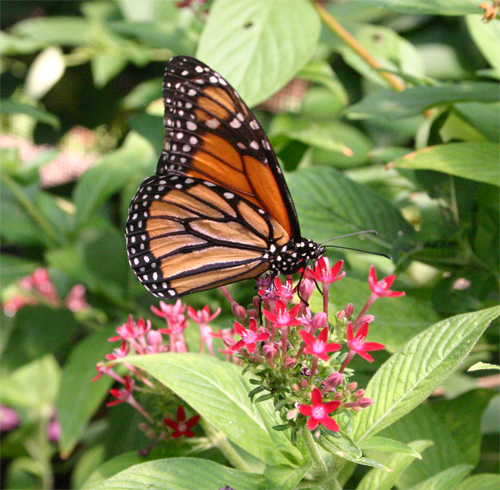
It was a zoo trip, so I can’t resist throwing in a couple of other animal pictures. Apparently I developed a rapport with some of the park residents. Like this komodo.
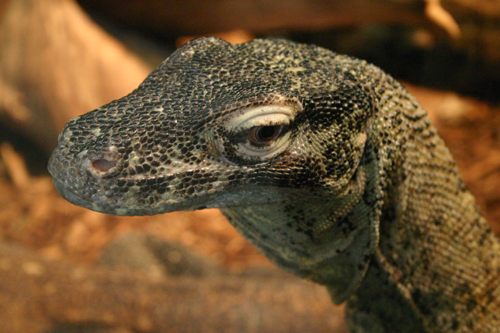
Lorikeets are great pollinators in their native region.
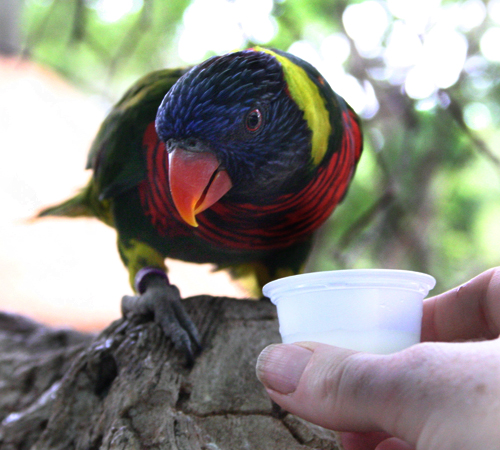 I really don’t know why the piranha kept looking at me like this. It was quite… unnerving. I can definitely say that I’m glad they aren’t in my pond!
I really don’t know why the piranha kept looking at me like this. It was quite… unnerving. I can definitely say that I’m glad they aren’t in my pond!
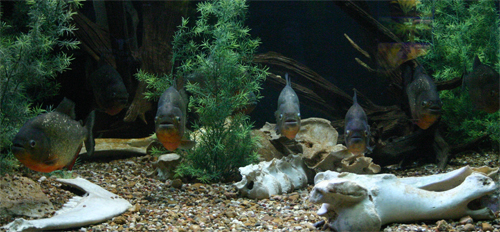 On a similar note, back on the home front, I’m also glad that I chose NOT to put a killifish in my pond. I came home to discover that the killifish we had is the culprit behind my disappearing fish in my indoor aquarium — I found this out because it had my last neon tetra sticking out of his mouth (after it apparently devoured all the rest). Needless to say, he’s off to a new home with bigger bullies than he is, and the rest of my fish can be at peace. I had planned to add a local variety of killifish to my pond. HA! No more. I didn’t bother to take a picture of the killifish before I grabbed that net and got him out of there! Sorry! Look it up — and then don’t buy one!
On a similar note, back on the home front, I’m also glad that I chose NOT to put a killifish in my pond. I came home to discover that the killifish we had is the culprit behind my disappearing fish in my indoor aquarium — I found this out because it had my last neon tetra sticking out of his mouth (after it apparently devoured all the rest). Needless to say, he’s off to a new home with bigger bullies than he is, and the rest of my fish can be at peace. I had planned to add a local variety of killifish to my pond. HA! No more. I didn’t bother to take a picture of the killifish before I grabbed that net and got him out of there! Sorry! Look it up — and then don’t buy one!
On the plus side, we did get a bit of rain here in Austin. I did a little happy dance.
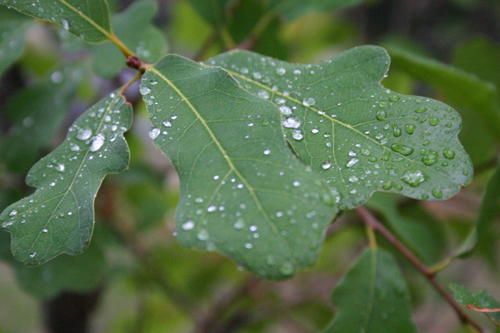 And I found a surprise little bloom in my pond.
And I found a surprise little bloom in my pond. I really need to learn the name of this plant sometime. Now that it’s blooming, it doesn’t look like the plant(s) I thought it might be. Ah well, the bloom will be the identifier when I next visit the pond center. It’s a Pickerel Weed — thanks, Bob!
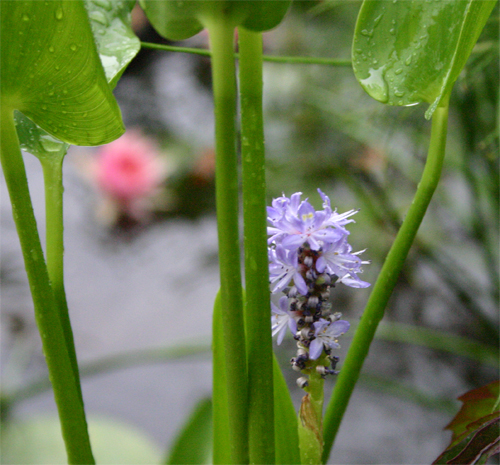
What’s the first rule about planting in the Texas summer, especially during a heat wave?
DON’T.
But here’s my dilemma. The boys and I wanted to get a little plant for the bees because it’s Pollinator Week. So we went down to Natural Gardener and selected a little pincushion flower. Why? Because it had a happy little bee already on it! (We didn’t take the bee home.) Is it native? No, I don’t think so. Is it drought hardy? I really hope so. Basically I broke all sorts of rules yesterday (it was the gardener mom in me — the kids were excited about a plant, and then so was I). Because after choosing the pincushion (and a rudbeckia), I headed back toward the cashier, turned the corner, and found…
Dutchman’s Pipevine! This beautiful little vine is not available that often in the nurseries, and not only had Natural Gardener just gotten some in for the first time this year, the vines were big, beautiful, blooming, and covered in little eggs. Dutchman’s Pipevine (Aristolochia fimbriata) is the host plant for a gorgeous butterfly called the Pipevine Swallowtail. Natural Gardener is known for having tons of these plants in their butterfly garden — they are usually covered with munching little caterpillars, and Pipevine chrysalises can be discovered in unusual places all over their garden. Many Austinites covet these plants, and I am no exception. Just look at this gorgeous flower. No, it’s not native. See, another rule broken.
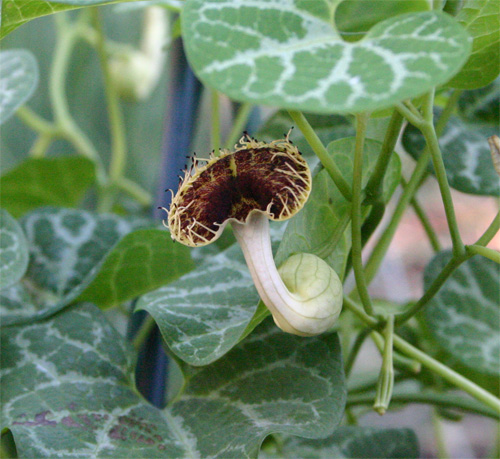
And the plants already have many little swallowtail eggs on them.
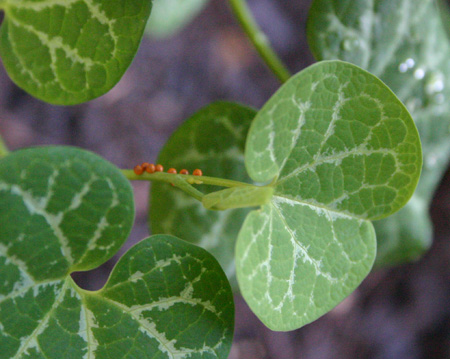 Here’s a caterpillar picture I took last year.
Here’s a caterpillar picture I took last year.
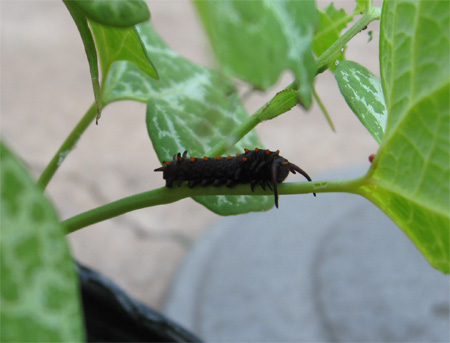 I bought one last fall, and it has survived some of the worst my household and environment can do to anything. The dogs dragged it all over the yard from the start, and in tears I re-planted the little remaining root in the front, and I babied it over the winter and amazingly it survived. During that time it got completely smothered by falling leaves off my roof. I gingerly removed them. Then in March we got hit with a terrible hail storm with golf-ball sized hail. It survived. I thought it was done for when the roofers dropped tons of roofing material onto that bed. smooshing the plant. When I got all the debris off, all the leaves were gone. But I left the root in, and lo and behold, that little baby sprouted new leaves and looks better than ever. Small, but alive.
I bought one last fall, and it has survived some of the worst my household and environment can do to anything. The dogs dragged it all over the yard from the start, and in tears I re-planted the little remaining root in the front, and I babied it over the winter and amazingly it survived. During that time it got completely smothered by falling leaves off my roof. I gingerly removed them. Then in March we got hit with a terrible hail storm with golf-ball sized hail. It survived. I thought it was done for when the roofers dropped tons of roofing material onto that bed. smooshing the plant. When I got all the debris off, all the leaves were gone. But I left the root in, and lo and behold, that little baby sprouted new leaves and looks better than ever. Small, but alive.
Back to the heat wave. We are having one of the worst Junes ever — 100-104 degrees Fahrenheit — usually we are mid-90s about now. Is this the time to plant? Absolutely not.
But at my house, if you want a plant to survive, you either:
1) Don’t buy it.
2) Get it in the ground fast with a good dose of water, and then some more. Otherwise, the dogs will drag it across the yard or eat it, or the sun will bake it on the porch.
So, yes I bought the plants because they are so hard to get and were stunning. Yes, I planted them (with lots of mulch). And yes, I’m prepared to baby them like you wouldn’t believe. I’ll set up a tent for extra afternoon shade if I have to. I will love them, and pet them, and name them George!
Austinites, if you have been wanting Dutchman’s Pipevine, too, I suggest you get down to Natural Gardener today!
Here are my other two flowers — the pincushion and the rudbeckia.
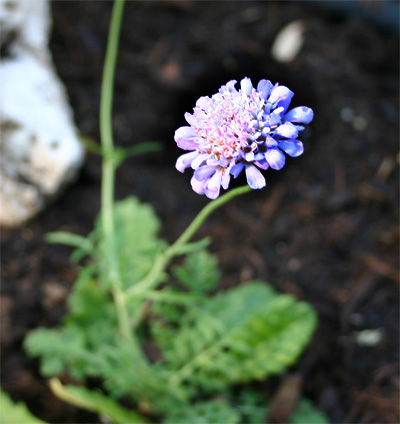
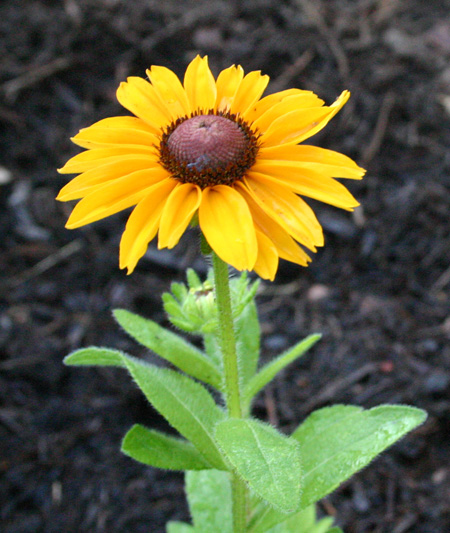
Stay cool and out of the sun, Texans — unless you are out there creating shade with your body to protect your precious new plants, like I will be!
What’s all the buzz about? It’s National Pollinator Week here in the United States. It’s a time to spread the word about the desperate plight of our flower-visiting, pollen-spreading friends. Because of pollinators’ declining populations, many farms and flowers are already in trouble! Missing native plants, too many pesticides, and diseases have all contributed to drastically reduced numbers of bees, butterflies, and other pollinators.
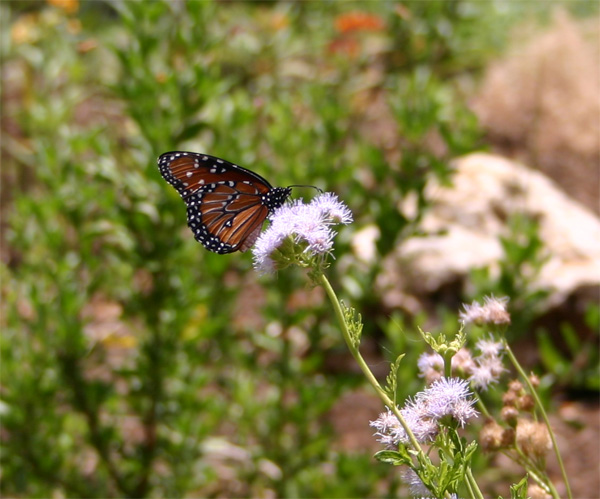 That’s a queen butterfly on Gregg’s mistflower (Conoclinium greggii) — the butterflies, especially queens and monarchs, go crazy for Gregg’s mistflower. I had hoped to get some pictures of bees visiting my flowers, but they were camera-shy (there were some yellow-jackets, though, but they were a little TOO friendly, if you know what I mean). At least my trusty butterfly and hummingbird friends came out for pictures. Ignore the lawnmower cord and ugly ground in the background.
That’s a queen butterfly on Gregg’s mistflower (Conoclinium greggii) — the butterflies, especially queens and monarchs, go crazy for Gregg’s mistflower. I had hoped to get some pictures of bees visiting my flowers, but they were camera-shy (there were some yellow-jackets, though, but they were a little TOO friendly, if you know what I mean). At least my trusty butterfly and hummingbird friends came out for pictures. Ignore the lawnmower cord and ugly ground in the background.
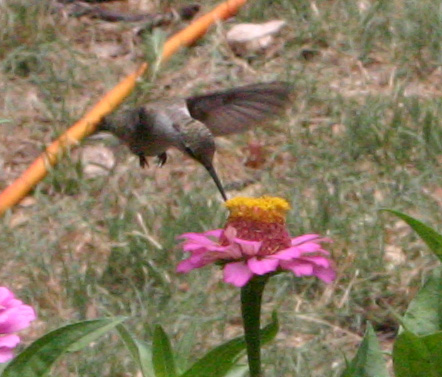 How can you help? If you have a garden, especially an organic one, you are probably already doing tons to help the populations of bees and other pollinators. But Pollinators Week for me is an excuse to go out and buy a native plant just for the sake of the wildlife, so as soon as I finish this blog entry, the boys and I are going to Natural Gardener to pick out something new. And we are determined not to let it die in the hot Texas sun (maybe a shade plant, lol). Not sure what to get? Enter in your zip code for an eco-regional planting guide on what plants are helpful in your region.
How can you help? If you have a garden, especially an organic one, you are probably already doing tons to help the populations of bees and other pollinators. But Pollinators Week for me is an excuse to go out and buy a native plant just for the sake of the wildlife, so as soon as I finish this blog entry, the boys and I are going to Natural Gardener to pick out something new. And we are determined not to let it die in the hot Texas sun (maybe a shade plant, lol). Not sure what to get? Enter in your zip code for an eco-regional planting guide on what plants are helpful in your region.
A kidneywood — bees love this plant! Well, they will, once it’s big and blooming (it’s a tiny little thing right now). Whenever I pass a larger kidneywood, bees are swarming all over it. I can’t wait!
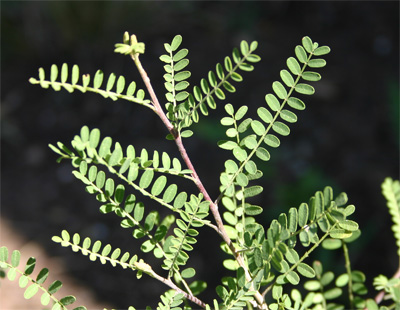 Plant something new in your garden that is a bee favorite. Go native — invasive plants contribute to the plight of beneficial insect and bird populations. Plant larval food for the caterpillars and rejoice when you see your plant get eaten by little happy caterpillars. Build a little habitat that might be a perfect home for a hive. Make a mud puddle for bees and butterflies to drink from. Do you have fruit bats in your area? Build a bat house for them!
Plant something new in your garden that is a bee favorite. Go native — invasive plants contribute to the plight of beneficial insect and bird populations. Plant larval food for the caterpillars and rejoice when you see your plant get eaten by little happy caterpillars. Build a little habitat that might be a perfect home for a hive. Make a mud puddle for bees and butterflies to drink from. Do you have fruit bats in your area? Build a bat house for them!
Make a commitment to avoid pesticides and chemical fertilizers. This is HUGE. Even organic pest controls can affect the population of good insects — so research before you buy and/or use any kind of product or method! And educate your friends and neighbors about the plight of bees and the dangers of pesticides and chemical fertilizers!
In this picture, there’s milkweed, flame acanthus, blackfoot daisies, and pentas, all together.
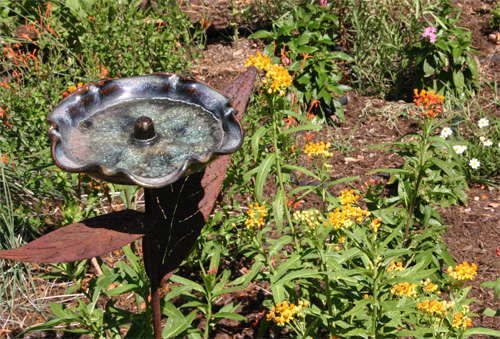
This is one of my favorite butterflies — the Gulf Fritillary. It has a stunning orange wingspread, but underneath it’s orange, silver, and black. I’m not sure which side I like best, which is why I like it so much.
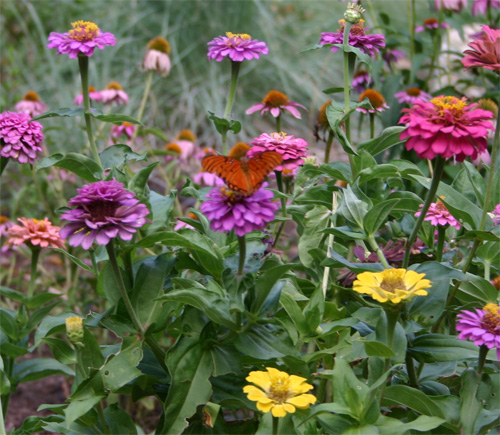
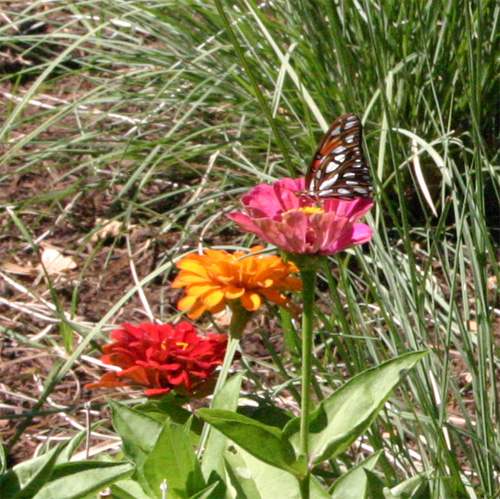
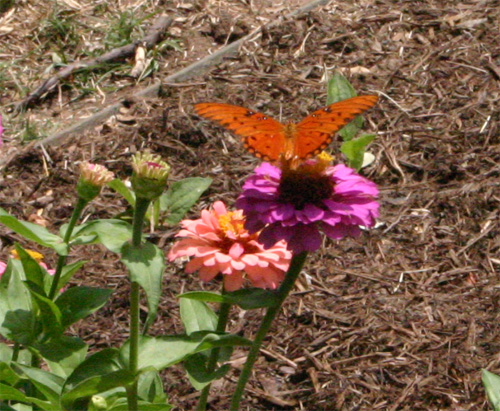 Ah, here’s one of my absolute favorites of the Texas natives, the wafer ash, or hop tree (Ptelea trifoliata). It can be hard to find in a nursery, but it’s easy to grow from seed, and they’re all over. Our dogs ate the top off our first one, and it amazingly grew back, the determined little thing. The wafer ash is a host plant of the giant swallowtail and tiger swallowtail. It’s part of the citrus family, and it’s one time that leaves of three (trifoliata) are a good thing. They have nothing to do with poison ivy, by the way, so get that out of your mind!
Ah, here’s one of my absolute favorites of the Texas natives, the wafer ash, or hop tree (Ptelea trifoliata). It can be hard to find in a nursery, but it’s easy to grow from seed, and they’re all over. Our dogs ate the top off our first one, and it amazingly grew back, the determined little thing. The wafer ash is a host plant of the giant swallowtail and tiger swallowtail. It’s part of the citrus family, and it’s one time that leaves of three (trifoliata) are a good thing. They have nothing to do with poison ivy, by the way, so get that out of your mind!
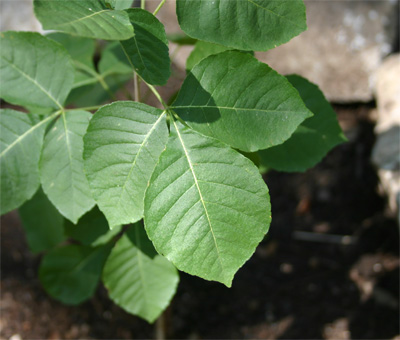
Swallowtails enjoy other citrus — we have a mandarin orange, lemon, and two lime trees growing. No fruit yet! But I’m hopeful that as long as I don’t kill them, I’ll have fruit someday. Look, here’s a little fly sort of a thing on my lime tree. Flies are great pollinators!
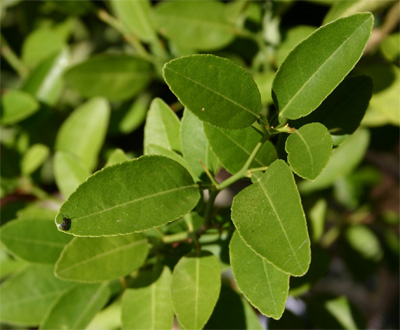
Here’s a yellow jacket on the baby Goldenball Leadtree (Leucaena retusa). Yellow jackets are minor pollinators as well as predatory wasps. I’m happy to have them around my garden, just not building hives under my eaves right where I’m building a new bed! The yellow jackets and I are currently having a discussion about where it’s ok to build a hive and where it isn’t. I haven’t killed one, but I do remove their little hives in an effort to get them to move elsewhere. Oh, and the dogs also ate the goldenball leadtree over the winter, too. It grew back. Yay for native plants.
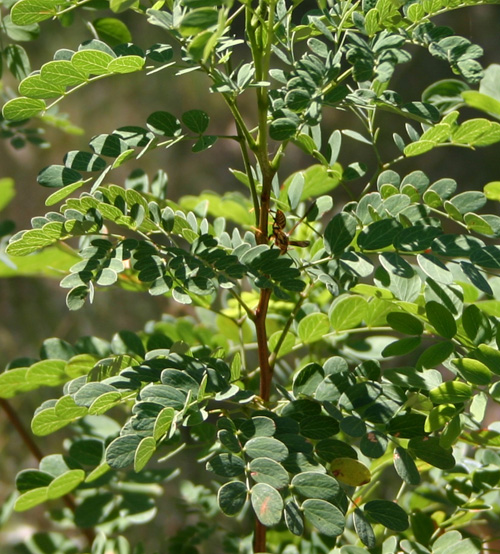 This one is almost native — it’s a Mexican Anacacho Orchid. We planted it a little too deep, I think — it lives, but I feel it’s struggling a bit. I hope to get a true native Anacacho Orchid in the fall. They are gorgeous when blooming.
This one is almost native — it’s a Mexican Anacacho Orchid. We planted it a little too deep, I think — it lives, but I feel it’s struggling a bit. I hope to get a true native Anacacho Orchid in the fall. They are gorgeous when blooming.
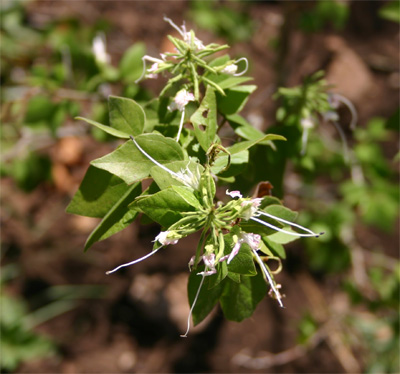 Bees even like catmint! Catmint’s not just for cats anymore!
Bees even like catmint! Catmint’s not just for cats anymore!
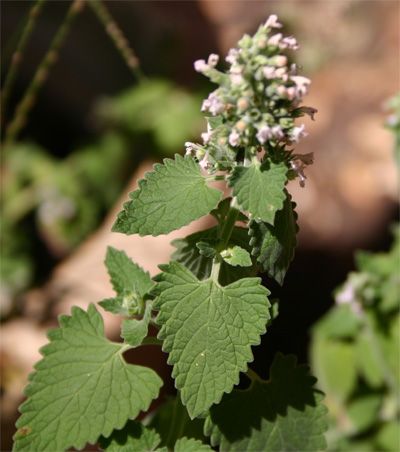
And who could forget the all-time bee favorite, the sunflower. Here’s mine:
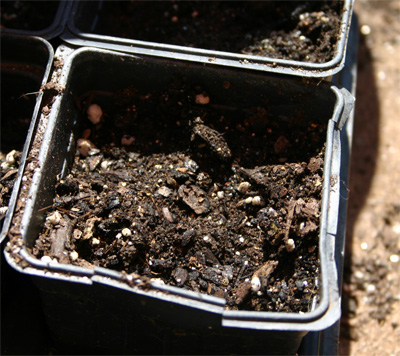 My last batch of seeds I lightly spread into the ground where I wanted them to grow. They didn’t. So now I’m trying to grow sunflowers in little planters, and hopefully they’ll grow into seedlings. I love sunflowers. My husband said he always thought of them as a weed, not as a pretty flower (gasp!). When he sees them in the back of the yard with the prickly pear and the white TX honeysuckle and the goldenball leadtree, he’ll come around. I know he will.
My last batch of seeds I lightly spread into the ground where I wanted them to grow. They didn’t. So now I’m trying to grow sunflowers in little planters, and hopefully they’ll grow into seedlings. I love sunflowers. My husband said he always thought of them as a weed, not as a pretty flower (gasp!). When he sees them in the back of the yard with the prickly pear and the white TX honeysuckle and the goldenball leadtree, he’ll come around. I know he will.
So in honor of Pollinators Week, bee happy and make a bee happy. And then those vegetables and fruits and pretty flowers and trees you love will be around for you — and your grandkids– to enjoy.
I know that part of the natural process of establishing a healthy pond is going through an initial algae bloom, but all the same it’s a bit of a shock to see it.
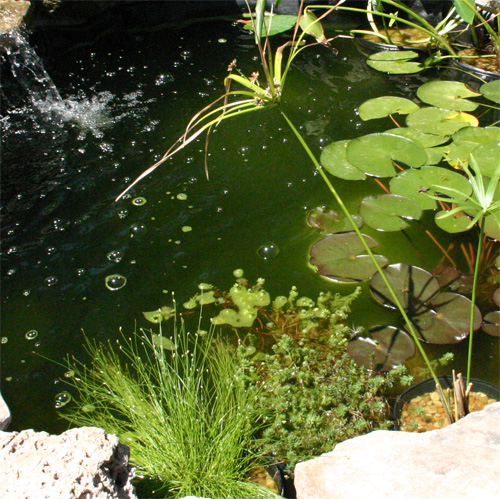 I hope that it’s not going to get worse before it gets better. I rushed right out today to get more aquatic plants to hog the nutrients in the water. The local pond nurseries are going through a shortage of the submerged plant called Hornwort, but Emerald Gardens had some healthy new anacharis, so I headed right down. It was my first time to the store, and I’m glad to report that they have a good selection of pond plants to choose from. I didn’t get too many pictures at the store (I have kids, and it was hot), but I enjoyed walking through.
I hope that it’s not going to get worse before it gets better. I rushed right out today to get more aquatic plants to hog the nutrients in the water. The local pond nurseries are going through a shortage of the submerged plant called Hornwort, but Emerald Gardens had some healthy new anacharis, so I headed right down. It was my first time to the store, and I’m glad to report that they have a good selection of pond plants to choose from. I didn’t get too many pictures at the store (I have kids, and it was hot), but I enjoyed walking through.
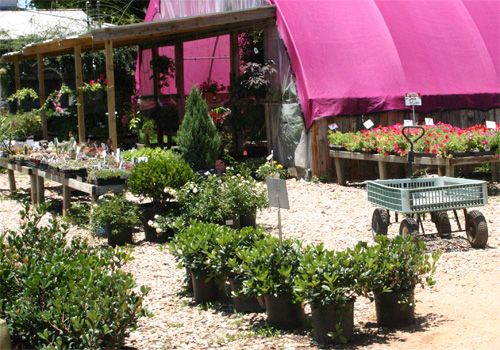
They, of course, have a variety of both native and non-native plants. I saw quite a few beautiful plants that I have a suspicion would not be found in a xeriscaped garden. The main attractions, though, were the ponds, and they were plentiful and very lovely. Did I get pictures? Nope. Next visit!
There was a very cool and very tall plant — it wasn’t labeled, but check out this stem:
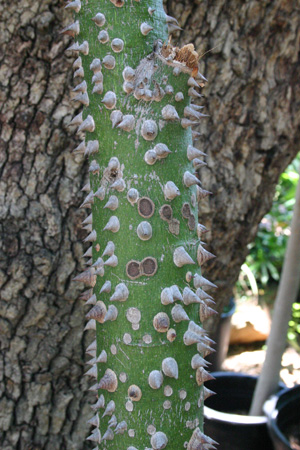 I picked up some anacharis, a small maidenhair fern, and this dwarf papyrus. It was big, healthy, and hard to resist.
I picked up some anacharis, a small maidenhair fern, and this dwarf papyrus. It was big, healthy, and hard to resist.
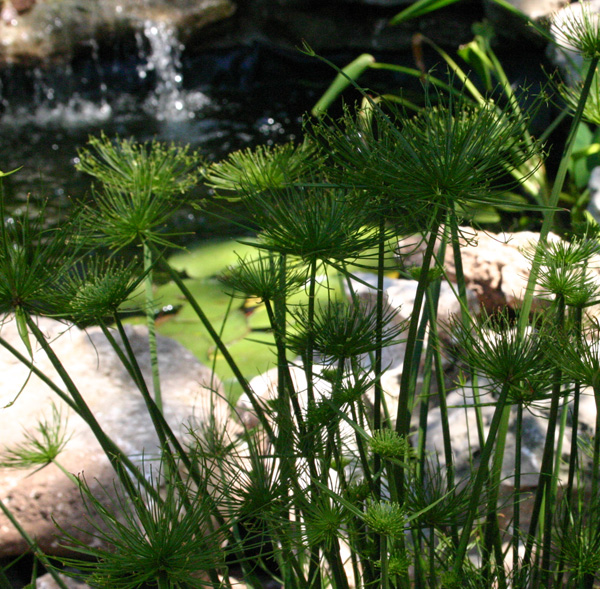 On the way home (read: detour), I stopped by Natural Gardener to see if they had some horsetail reed (Equisetum hyemale) (they had some at Emerald Gardens, but I was looking for an excuse to go to NG). I should have gotten some at Emerald Gardens, because NG currently only had the giant horsetail in the 1-gallon size I was looking for. But I did buy a Texas Star Hibiscus (Hibiscus coccineus) for the pond. I love how the leaves change in appearance as they mature.
On the way home (read: detour), I stopped by Natural Gardener to see if they had some horsetail reed (Equisetum hyemale) (they had some at Emerald Gardens, but I was looking for an excuse to go to NG). I should have gotten some at Emerald Gardens, because NG currently only had the giant horsetail in the 1-gallon size I was looking for. But I did buy a Texas Star Hibiscus (Hibiscus coccineus) for the pond. I love how the leaves change in appearance as they mature.
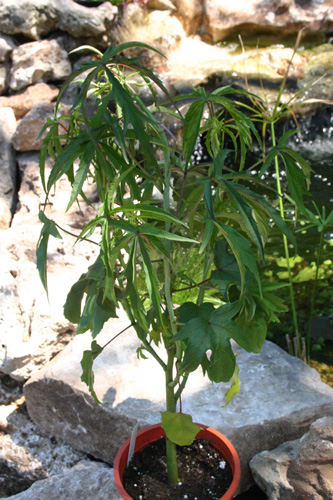 I also went a little crazy and bought several other 4-inch plants to fill up the gaps in my butterfly/hummingbird garden. I usually try so hard to go mostly native, but I ended up gleefully giving in to an assortment of drought-tolerant plants — some native, some not — that I’ve always wanted but hadn’t ever bought, or perhaps didn’t buy enough of: gayfeather, bat-face cuphea (ok, turns out that one perhaps needs more water than it’s likely to get), cigar plant, white gaura, pink gaura, rock rose, and some extra milkweed. I accidentally bought some bee balm — which seems to require moisture, so it might get put over by the air conditioner, pond, or in a container. And I bought a small dwarf bottlebrush (from Emerald Gardens) to go in the container left empty after the dogs ate the dwarf pomegranate.
I also went a little crazy and bought several other 4-inch plants to fill up the gaps in my butterfly/hummingbird garden. I usually try so hard to go mostly native, but I ended up gleefully giving in to an assortment of drought-tolerant plants — some native, some not — that I’ve always wanted but hadn’t ever bought, or perhaps didn’t buy enough of: gayfeather, bat-face cuphea (ok, turns out that one perhaps needs more water than it’s likely to get), cigar plant, white gaura, pink gaura, rock rose, and some extra milkweed. I accidentally bought some bee balm — which seems to require moisture, so it might get put over by the air conditioner, pond, or in a container. And I bought a small dwarf bottlebrush (from Emerald Gardens) to go in the container left empty after the dogs ate the dwarf pomegranate.
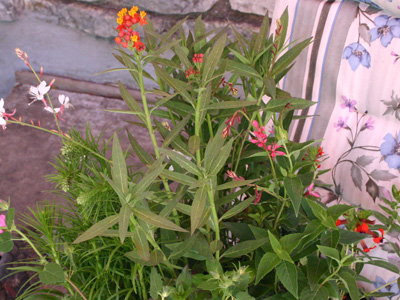 I am determined to have a healthy garden for monarchs, queens, and other butterflies. My current plants were just not doing as well as I’d like, though — the aphids took their toll this year. I went too long without removing those nasty pests, and the ladybugs had poor timing. I hesitate to show these pictures of my suffering milkweeds after Fairegarden showed such gorgeous pictures yesterday of Butterfly weed, Asclepias tuberosa, complete with butterflies. But she inspired me to go inspect my related plants, Asclepias curassavica, and ugh, they seemed so stunted because of the aphids. Hose came out, I washed the aphids off, at least until I found a ladybug feasting–those aphids stayed. And so I bought a couple of healthy ones from Natural Gardener to add in, just cause.
I am determined to have a healthy garden for monarchs, queens, and other butterflies. My current plants were just not doing as well as I’d like, though — the aphids took their toll this year. I went too long without removing those nasty pests, and the ladybugs had poor timing. I hesitate to show these pictures of my suffering milkweeds after Fairegarden showed such gorgeous pictures yesterday of Butterfly weed, Asclepias tuberosa, complete with butterflies. But she inspired me to go inspect my related plants, Asclepias curassavica, and ugh, they seemed so stunted because of the aphids. Hose came out, I washed the aphids off, at least until I found a ladybug feasting–those aphids stayed. And so I bought a couple of healthy ones from Natural Gardener to add in, just cause.
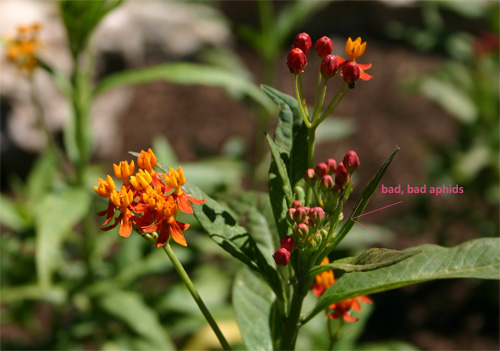 I’ll finish with a lovely rock rose (Pavonia lasiopetala) that already looks perfect next to the limestone rocks of the pond, and it’s not even in the ground yet!
I’ll finish with a lovely rock rose (Pavonia lasiopetala) that already looks perfect next to the limestone rocks of the pond, and it’s not even in the ground yet!
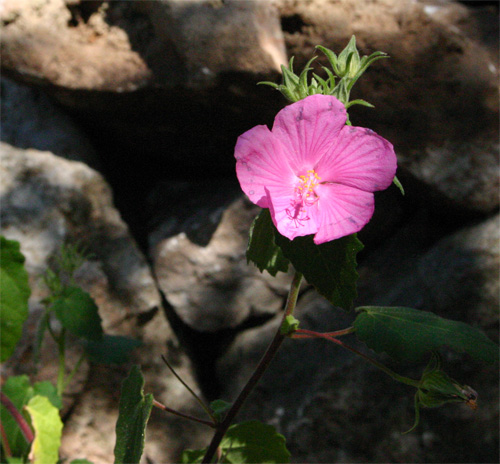
Aquatic creatures now call our pond home — yesterday I added four little goldfish, which cost me a total of 82 cents. They seemed a bit stunned at first about the new pond, but within moments they rediscovered each other and checked out the pond. Today they are quite active, so I have high hopes that they will thrive and grow. Supposedly they will grow fast when not cramped in a tank with a thousand other fish.

I was distracted from the fish by movement in my peripherals…
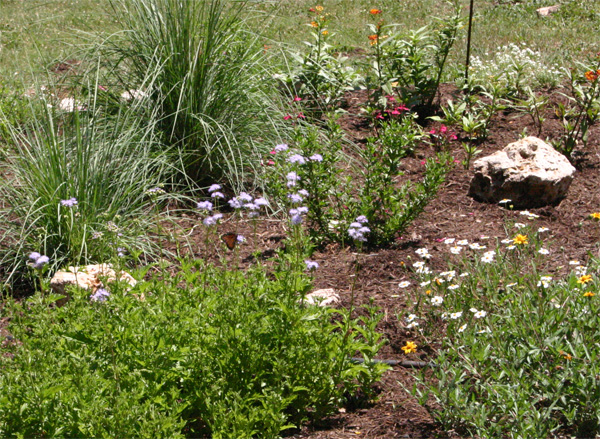
Two queen butterflies were busily dancing around each other and visiting our newly blooming Gregg’s mistflower (Conoclinium greggii). I tried to linger long enough to get a close-up, but it was noon, and the Texas sun was beating down on me. Would that I had a zoom lens for my camera (hubby, read this)!
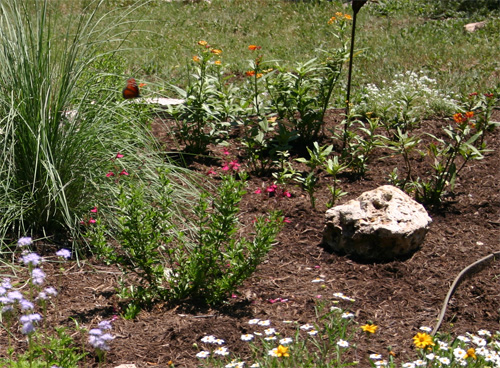 Still, it gave me a chance to show how our butterfly garden is growing. It’s come a long way since the first fall digging of earth and the first little plants of spring. The colors are a garden in and of themselves.
Still, it gave me a chance to show how our butterfly garden is growing. It’s come a long way since the first fall digging of earth and the first little plants of spring. The colors are a garden in and of themselves.
Despite the fact that our butterfly garden has been dedicated as such, the old grass is trying to reestablish its territory. So every morning I go out to pull grass. It’s amazingly hard to pull it out with its roots in this clay soil, so chances are I’ll be pulling grass for some time to come. On the plus side, I get to spent ample time admiring the wildlife that is frequenting the garden. This morning I enjoyed, among others, Monarch, Queen, Skipper, Sulphur, and Tiger Swallowtail butterflies. They’d fly over me, casting shadows the size of birds, and as I looked up I’d see a vision of color fluttering by.
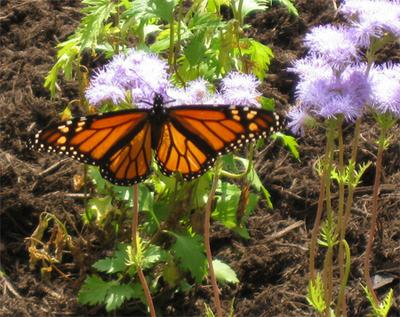 This morning also brought a dragonfly and a small centipede, which crawled quite close to my flip-flop-exposed toes. I just studied it for awhile and went back to my gardening. After all, a centipede, while hazardous to humans, is quite the bug predator and is welcome in my garden. On the other hand, perhaps I should stop wearing flip flops!
This morning also brought a dragonfly and a small centipede, which crawled quite close to my flip-flop-exposed toes. I just studied it for awhile and went back to my gardening. After all, a centipede, while hazardous to humans, is quite the bug predator and is welcome in my garden. On the other hand, perhaps I should stop wearing flip flops!
Happily all my plants are doing well. The rains we had last week assured me that my front yard plants are finally getting established — they have really settled in and started growing. It’s fun to see all so many blooms on small plants. It’s like watching small kids learning to do grown-up things. Here’s a close-up of a milkweed bloom.
I should correct my statement to say that all of my plants that have survived the dogs are doing well. The thundering husky and his girlfriend do their best to trample the garden or eat young seedlings. Hopefully, if all goes well, one of these days the surviving plants will be large enough that the dogs will go around, instead of through, the garden. If only the dogs could pull up the grass for me — that would be okay.